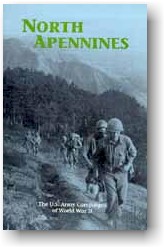World War II was the largest and most violent armed conflict in the history of mankind. However, the half century that now separates us from that conflict has exacted its toll on our collective knowledge. While World War II continues to absorb the interest of military scholars and historians, as well as its veterans, a generation of Americans has grown to maturity largely unaware of the political, social, and military implications of a war that, more than any other, united us as a people with a common purpose.
Highly relevant today, World War II has much to teach us, not only about the profession of arms, but also about military preparedness, global strategy, and combined operations in the coalition war against fascism. To commemorate the nation's 50th anniversary of World War II, the U.S. Army has published a variety of materials to help educate Americans about that momentous experience. These works provide great opportunities to learn about and renew pride in an Army that fought so magnificently in what has been called "the mighty endeavor."
World War II was waged on land, on sea, and in the air over several diverse theaters of operation for approximately six years. The following essay is one of a series of campaign studies highlighting those struggles that, with their accompanying suggestions for further readings, are designed to introduce you to one of the Army's significant military feats from that war.
This brochure was prepared in the U.S. Army Center of Military History by Dwight D. Oland. I hope this absorbing account of that period will enhance your appreciation of American achievements during World War II.
JOHN W. MOUNTCASTLE
Brigadier General, USA
Chief of Military History
North Apennines10 September 1944-4 April 1945
By the end of the first week of August 1944 members of the British Eighth Army stood on the Ponte Vecchio, bridging the Arno River in recently liberated Florence, Italy. The Eighth Army had just completed a campaign, in conjunction with the U.S. Fifth Army, that had kept Axis forces in Italy in full retreat, unable to halt the Allied drive north of Rome that had begun with Operation DIADEM the previous May. For the first time since the Italian campaign had begun, Allied leaders were optimistic that they were on the verge of pushing the Germans out of the northern Apennines and sweeping through the Po Valley beyond. After that, many hoped for a rapid advance into the Alps, the Balkans, and perhaps into Austria, before winter and the enemy could stem their advance.
Strategic Setting
The Italian campaign thus far had been long, arduous, and frustrating. In September 1943 the armies of the United States and Great Britain and the Commonwealth, fresh from victories in North Africa and Sicily, invaded the southern Italian peninsula at three locations. Allied predictions that the German Army would quickly retreat to the Alps after Italy left the war on 8 September proved wrong. Axis forces tenaciously defended every mountaintop and valley amid deteriorating winter weather from behind a series of fortified lines that stretched across Italy from the Tyrrhenian Sea to the Adriatic. After spending the winter of 1943-44 stalled at the Gustav Line and within a small beachhead at Anzio south of Rome, the U.S. Fifth and the British Eighth Armies succeeded in overwhelming enemy defenses in May, advanced up the Liri Valley, and liberated Rome in June. Then, in a two-month long summer campaign that was very uncharacteristic of Italian operations until that time, Allied forces pushed the enemy 150 miles north to the Arno River by mid-August. Axis forces, however, began new preparations to frustrate any continuation of the Allied drive by building another belt of fortifications, the Gothic Line. The new line generally consisted of a series of fortified passes and mountaintops, some fifteen to thirty miles in depth north of the Arno River and stretched east from the Ligurian Sea through Pisa, Florence, and beyond. Farther east, along the Adriatic coast where the northern Apennines sloped down
[3]
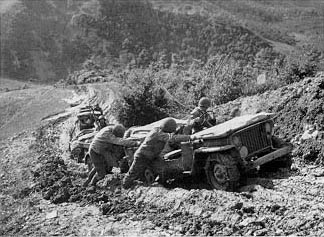
Motor transport in northern Apennines. (DA photograph)
onto a broad coastal plain, Gothic Line defenses were generally anchored on the numerous rivers, streams, and other waterways flowing from the mountains to the sea. One key to the line appeared to be the central Italian city of Bologna, a major rail and road communications hub located only a few miles north of the defensive belt.
The intense combat operations of the summer were not destined to continue into the fall. With the liberation of Rome on 4 June and the invasion of Normandy two days later (Operation OVERLORD), Allied resources earmarked for Italian operations, already considered of secondary importance, steadily diminished. The Allied invasion of southern France (Operation ANVIL-DRAGOON) on 15 August further reduced the limited resources available for the Italian theater. More important, ANVIL-DRAGOON stripped the armies in Italy of 7 first-class divisions, 3 American and 4 French, confirming in the minds of many Allied soldiers that Italy was a holding action of little importance.
Once the Allies reached the Gothic Line, they might have remained there for the rest of the war. Planners, however, were convinced that the Axis commanders could hold their positions with a minimal force, thus freeing units for duty elsewhere, in particular northwest Europe. They even surmised that the Germans were
4
attempting to conduct a reverse holding action in Italy by tying down a greater number of Allied troops than they themselves were forced to commit. In addition, British Prime Minister Winston S. Churchill was growing increasingly alarmed at the speed of Soviet advances on the Russian Front, which he felt threatened Western interests in Eastern Europe and, in particular, British interests in the Mediterranean. During the summer of 1944, therefore, he called for the Allies to redouble their Italian efforts, to press on into the Po Valley, and push east into the Balkans and north through the Ljubljana Gap, reaching the Danube Valley, Austria, and Hungary before the Red Army. The Americans, however, remained focused on northwest Europe. While they agreed to continue Italian operations with a minimum commitment of U.S. forces, they shared neither Churchill's concerns about Soviet intentions nor his zeal for campaigns in Eastern Europe. The Allies did plan, however, to continue offensive operations in the northern Apennines in the hope of breaking through the Gothic Line and advancing into northern Italy. A continuation of the offensive, they hoped, would at least prevent the Germans from transferring their forces in Italy elsewhere.
Operations
In August 1944 Field Marshal Sir Harold R. L. G. Alexander commanded the 15 Army Group in Italy, an Anglo-American force that eventually included troops from sixteen Allied nations. Within the 15 Army Group was Lt. Gen. Mark W. Clark's Fifth Army, composed of the U.S. IV Corps, commanded by Lt. Gen. Willis D. Crittenberger (three divisions), and the U.S. II Corps, commanded by Maj. Gen. Geoffrey Keyes (three divisions). Clark's forces held the western portion of the Allied line from the Ligurian Sea at the mouth of the Arno River to a point just west of Florence. To the east Lt. Gen. Sir Oliver Leese's larger Eighth Army, consisting of the Polish 2 Corps (two divisions), the Canadian 1 Corps (two divisions), the British 5 Corps (six divisions), the British 10 Corps (two divisions), and the British 13 Corps (three divisions), held the line from the Florence area to just south of Fano on the Adriatic coast.
Axis forces in Italy, designated Army Group C, were under the overall command of Luftwaffe Field Marshal Albert Kesselring. Opposing Clark's Fifth Army was Lt. Gen. Joachim Lemelsen's Fourteenth Army, which contained ten divisions belonging to the I Parachute and the XIV Panzer Corps. To the east, opposing the British Eighth Army, was the Tenth Army commanded by General Heinrich
5
von Vietinghoff. This army consisted of twelve divisions belonging to the LXXVI Panzer and the LI Mountain Corps. The two other Axis forces in northern Italy, the Ligurian Army and the Adriatic Command, controlled four more divisions and generally performed antipartisan and reserve missions.
Soon after British forces reached the Arno River on 4 August 1944, General Leese, noting the Eighth Army's armor superiority and the Fifth Army's loss of seven divisions, including the experienced mountain troops of the French Expeditionary Corps, recommended that his force attack up the Adriatic coast to Rimini. Once this attack had drawn Axis units away from the Fifth Army's front, General Clark could hit the Gothic Line in a secondary assault from Florence directly north toward Bologna with his more limited force. The Fifth and Eighth Armies could then converge on and capture Bologna and move to encircle and destroy Axis forces in the Po Valley, putting Eighth Army forces in a favorable position to move into the Balkans and the Danube Valley.
The proposal, code-named Operation OLIVE, appealed to Alexander, who had advocated similar "one-two punches" in the past. Clark, however, desiring a more independent and decisive role for the Fifth Army, initially agreed but asked for control of the British 13 Corps to enhance his main effort. His request revived hard feelings that stemmed from previous differences with General Leese, and the latter vehemently protested placing British troops under American command. Alexander, however, overrode his countryman's objections, and the Allies set to work ironing out several major operational problems.
The biggest dilemma facing the Allies concerned deception. As British forces were moved from positions in central Italy to prepare for the coastal offensive, Fifth Army units had to maintain pressure on the enemy to convince Axis commanders that the main thrust was still coming in the Florence area, while simultaneously extending their own lines to occupy positions vacated by the Eighth Army without attracting attention. The shift of British forces over battle-damaged and circuitous mountain routes began on 15 August. While this movement was made easier by the almost total lack of enemy air reconnaissance, it took the Eighth Army eight days, until 22 August, to redeploy eleven divisions and nine separate brigades on a 25-mile-wide front anchored on the Adriatic.
To mask the true nature of Operation OLIVE, Alexander decided to make it appear that the Fifth and Eighth Armies were making a routine noncombat approach up to the Gothic Line rather than launching an all-out offensive. When the Polish 2 Corps neared the Gothic Line on
6
the coast, Alexander's reserve forces marshaled behind the Poles were to launch a sudden, lightning attack through Polish positions and break the enemy defensive line. As soon as this happened, Fifth Army forces, which would have already crossed the Arno and closed on the rugged northern Apennines, would attack the Gothic Line north of Florence.
German radio communications and order-of-battle reports, intercepted and decrypted by ULTRA code-breaking operators in July and August, revealed to Alexander, Clark, and Leese that neither Kesselring nor any of his subordinates had detected the eastward shift of Fifth Army and Eighth Army units. Similarly, the Axis command did not realize that a change in Allied operational strategy had occurred or that an attack along the coast was imminent.
Operation OLIVE commenced on 25 August 1944 as the British 5 Corps and Canadian 1 Corps attacked through two Polish divisions on a seventeen-mile-wide front along the Adriatic. The offensive, supported by the British Desert Air Force, rapidly gained ground with the Canadian 5th Armored Division moving far forward against light resistance. Originally believing that the Eighth Army assault was a diversion to draw troops from central Italy, Kesselring delayed steps to reinforce units on the coast for four days, even though the Poles and Canadians had penetrated the Gothic Line near the coastal town of Pesaro on 30 August, threatening to turn the entire Axis front. Yet, taking advantage of the time provided by the Eighth Army's well-known proclivity for slow-moving, set-piece battles, and taking additional advantage of its failure to provide adequate armored reserves to exploit the unexpected breakthrough, Kesselring soon managed to plug the breach with the 26th Panzer, 29th Panzer Grenadier, and 356th Infantry Divisions. Maximizing the defensive advantages provided by inclement weather and numerous rivers and ridges, Axis units inflicted a total of 8,000 casualties on the attackers and stalled Eighth Army forces short of their Rimini and Romagna Plain objectives by 3 September. Despite the failure to exploit Canadian 1 Corps gains and perhaps end the war in Italy, Alexander was optimistic that Fifth Army's second punch would succeed.
General Clark planned to open his phase of Operation OLIVE on 10 September 1944 with an assault by all three corps under his command. In preparation, he had extended the front of his IV Corps (consisting of Task Force 45, the U.S. 1st Armored Division, and the South African 6th Armored Division) eastward from the Ligurian coast to approximately five miles west of Florence while anchoring the eastern wing of the British 13 Corps (with the British 1st, the Indian 8th, and
7
the British 6th Armored Divisions) east of Florence. In between was the U.S. II Corps, comprising the U.S. 34th, 91st, 85th, and 88th Infantry Divisions, concentrated on a narrow five-mile front.
From ULTRA intercepts, Clark knew that the German High Command had ordered Kesselring to prepare for an attack on the Futa
8
Pass in the center of the defending Fourteenth Army's line. The American general thus ordered an initial northward advance by his two flank corps across the Arno River to the Gothic Line in the wake of the now retreating Axis forces. Meanwhile, the U.S. 34th, 91st, and 85th Divisions of II Corps would follow, moving north along Highway 65,
9
the main road to Bologna through the Futa Pass. When the expected enemy resistance was encountered the 34th Division would launch a strong diversionary attack west of the Futa Pass, while the remaining II Corps units, led by the 91st Division with support from the 85th
Division, would bypass the Futa Pass to the east and attack the lightly
10
defended Il Giogo Pass on Route 6524 near the boundary of the Fourteenth and Tenth Armies. Once the Il Giogo Pass was taken, pressure would be put on the German flank at the Futa Pass, forcing the enemy to withdraw. The II Corps could then resume the advance north up Highway 65 to Bologna supported by all Fifth Army forces now totaling nearly 250,000 men.
As expected the Germans began withdrawing to the Gothic Line days before Fifth Army began its advance on 10 September. Initial resistance was thus light, but as the advancing forces reached the mountains, the intensity of combat increased. The Eighth Army's attack in the east had succeeded in diverting most enemy units away from the Futa Pass and II Giogo Pass areas except three regiments of the I Parachute Corps' 4th Parachute Division. In the west only the 362d and 65th Infantry Divisions faced the U.S. IV Corps, while just a single division, the 715th Infantry, opposed the British 13 Corps attack.
The U.S. 34th and 91st Divisions, with support from corps artillery, assaulted the Gothic Line on 12 September. The fighting was typical of the Italian campaign. The terrain facing Fifth Army units consisted of numerous mountain peaks, streams, deep valleys, broken ridges, and rugged spurs, all offering excellent defensive positions to the enemy. Although significant numbers of troops were involved on both sides, small unit actions predominated and rarely were units larger than a battalion engaged at any one time. The compartmented terrain tended to erode the Allies' three-to-one advantage in manpower, and whatever successes were gained were due largely to the individual soldiers' valor, resilience, and determination.
Although the Germans had heavily fortified the Futa Pass, they were surprised by the 91st and 85th Divisions' attacks against the Il Giogo Pass and nearby Monticelli Ridge and Monte Altuzzo. During
11
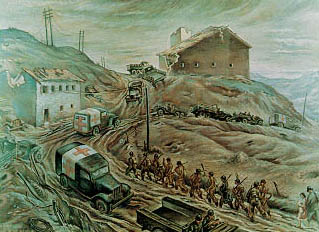
"Ebb and Flow of War, Monte Altuzzo, Italy, " by Harry A. Davis. (Army Art Collection)
six days of intense fighting between 12-18 September 1944, the 91st Division seized the Il Giogo Pass and Monticelli Ridge, while the 85th Division secured Monte Altuzzo. These successes outflanked the Futa Pass but cost over 2,730 II Corps casualties. Seeing the futility of continuing to defend that portion of the Gothic Line, the I Parachute Corps withdrew to the next set of ridges to establish another defensive line. Encouraged at having breached the Gothic Line in at least one sector, the Americans began a sustained mountain-by-mountain, ridge-by-ridge, and valley-by-valley drive toward Bologna. In response, the enemy tenaciously defended each position in a series of short, intense, small unit actions.
In such operations, the work of small combat units was pivotal. For example, the actions of Company B. 363d Infantry, U.S. 91st Division, led to the capture of II Giogo Pass. Forming the left flank of the 91st Division assault, Company B had inched up the Monticelli Ridge overlooking the pass on 14 September, using every scrap of sparse cover available. The two platoons leading the attack were soon stopped by enemy fire at twilight. Later that evening, one officer and six men crept forward, found the enemy gun position, and reported its location back
12
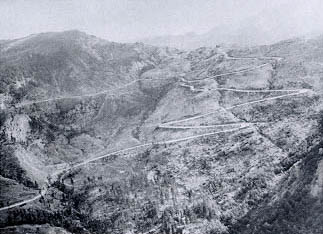
Top of Il Giogo Pass in the Gothic Line, looking toward the north. (DA photograph)
to Company B. The next morning, 15 September, artillery destroyed the strongpoint, allowing the company to resume its advance to a position just short of the ridge. At the time the unit had drawn ahead of its flanking units and consequently was receiving enemy fire from three sides. Fearing that the enemy would pin his unit down if the assault slowed, the platoon leader on the left flank decided to lead a bayonet charge to the summit fifty yards away. While enemy attention was momentarily focused elsewhere, the platoon charged and captured the northwest end of the ridge from the surprised German defenders. However, by the time the entire company had reached the summit, it had only seventy men and limited amounts of ammunition remaining.
The Germans counterattacked three times but were driven off with heavy casualties by well-placed artillery fire and the determined resistance of Company B. During the night sporadic enemy small-arms fire peppered the summit, wounding the company commander but failing to halt American resupply activities. For the next two days the Germans attempted to recapture the ridge through repeated counterattacks on Company B's left flank, an area held by fewer than twenty-five men. Again they failed.
13
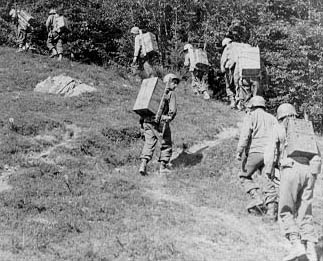
Infantry pack teams bring supplies to units fighting in the Gothic Line near Futa Pass. (DA photograph)
For the stubborn defense, much credit went to Pfc. Oscar G. Johnson. Located in an advanced position with five other soldiers, Johnson directed devastating direct fire against each enemy attack with ammunition and weapons gathered from the dead and wounded, cannibalizing damaged weapons to repair malfunctioning ones. Even after enemy fire had killed or wounded his entire squad and others sent to assist, Johnson held his position. Early in the morning of 17 September, the enemy attacks stopped. Johnson received the Medal of Honor for his actions. But Company B, now reduced to fifty men with all company officers dead or wounded, was too weak to clear the remainder of the ridge and was consolidated with Company G. Through such actions, II Corps units broke through the Gothic Line on a seven-mile front, attaining Fifth Army's objective of outflanking the Futa Pass.
As the Fifth Army continued its offensive, the British Eighth Army resumed Operation OLIVE on 12 September. In a classic demonstration of attrition warfare that took full advantage of overwhelming
14
Allied air, armor, and infantry firepower, the British 5 and Canadian 1 Corps smashed through defenses manned by the 29th Panzer Grenadier and 1st Parachute Divisions to capture Rimini, the gateway to the Romagna Plain on 21 September. Yet the Eighth Army had advanced only thirty miles in twenty-six days in the face of stubborn resistance, heavy rain, flooding, and mud. Nevertheless, despite the strain on its troops, on 22 September the Eighth Army pressed its attack northward beginning a three-month-long operation known as the "battle of the rivers." During this series of engagements, the Eighth Army, again taking advantage of its overwhelming materiel superiority, moved from river to river, under extremely adverse weather conditions, only gradually overcoming heavy Axis resistance.
On the Fifth Army front, the capture of the Il Giogo and Futa Passes ended the American phase of Operation OLIVE. Meanwhile, General Clark weighed two future courses of action. He could follow his original plan and attack north up Highway 65 to Bologna or further exploit the boundary of the Fourteenth and Tenth Armies by driving northeast toward Imola with two divisions supported by armor and artillery. He decided upon the latter option since it would exploit German organizational confusion and better support the Eighth Army's continuing offensive by threatening to squeeze the enemy between the two Allied forces.
After surveying Route 6528 to Imola, however, Clark realized that the narrow road could not support more than a single division under combat conditions. Therefore, he decided to send the U.S. 34th, 91st, and 85th Divisions north up Highway 65 as originally planned. But not wanting to give up the possibility of accomplishing a breakthrough between the Fourteenth and Tenth Armies, he also ordered the U.S. 88th Division, supported by the U.S. 1st Armored Division's Combat Command A (CCA), along Route 6528 toward Imola.
Recognizing the drive on Imola as the more dangerous threat, the German command reinforced the elements of three divisions already in the area with the 715th Infantry and Austrian 44th Reichsgrenadier Divisions. The American advance thus rapidly degenerated into a series of small unit actions contesting each mountaintop and ridge line. However, the 88th Division moved steadily forward, and by 27 September the Americans had advanced halfway to Imola, capturing in the process all of the high ground surrounding their positions with the exception of one peak.
Yet taking ground did not always mean that the territory was permanently secured. For example, although the 2d Battalion, 350th Infantry, U.S. 88th Division, with the aid of Italian partisans, had eas-
15
ily taken the summit of 2,345-foot-high Monte Battaglia east of Route 6528 on the afternoon of 27 September, the enemy immediately shelled the battalion's position and mounted repeated counterattacks to retake the mountain. When a determined regimental-size attack by troops of the 44th Reichsgrenadier Division threatened to
16
either push the 2d Battalion from the summit or annihilate it, the commander of Company G. 350th Infantry, Capt. Robert E. Roeder, provided inspiration to the defenders. Constantly moving among his men, encouraging them and directing their fire against the enemy, he held his unit together during an almost continuous series of battles. During the sixth counterattack, the enemy, using flamethrowers and taking advantage of a dense fog, nearly succeeded in overrunning Company G's position. But Roeder led his men in a fierce battle at close quarters to beat back the enemy attack with heavy losses. The following morning, while repulsing yet another counterattack, Roeder was seriously wounded by shell fragments, rendered unconscious, and carried back to his company command post. There he refused medical attention, and instead dragged himself to the door of the command post to defend it, firing his weapon at the advancing enemy, and shouting words of encouragement and issuing orders to his men before being killed by shell fragments. Captain Roeder's courageous leadership galvanized the spirit of his men and was recognized by the posthumous award of the Medal of Honor.
After receiving reinforcements and massive artillery support that overwhelmed the attacking enemy units, the 2d Battalion finally secured "Battle Mountain," as Monte Battaglia was now called. Although more German counterattacks came in the days that followed, all were repulsed, and the remnants of the 2d Battalion were finally relieved by the British 1st Guards Brigade on 5 October.
While the 88th Division was struggling to punch through the German units blocking the road toward Imola, the remaining three divisions of the II Corps continued their advance along Highway 65 toward Bologna. After securing the Futa Pass, the 85th, 91st, and 34th Divisions, in line abreast from east to west, moved out to capture the Radicosa Pass, ultimately seizing three major peaks on the ridge. These successes, along with the capture of Battle Mountain, forced the Germans to withdraw from their outflanked positions.
17
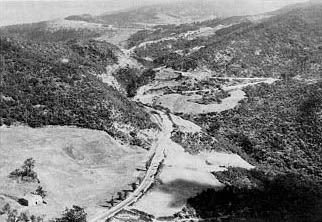
Highway 65 at Futa Pass. (DA photograph)
But the journey had been difficult for the American units. From 22 September to the end of the month, II Corps units had pushed only six to eight miles closer to the Po Valley. The inclement weather that had already slowed Eighth Army's advance farther east now diminished the intensity of Fifth Army's attack. Fog and mist drastically decreased visibility while torrential rains swelled streams, washed out bridges, and created quagmires that made troop and supply movements over mountain trails difficult and treacherous. When faced with the additional factors of stiffening enemy resistance and the immediate lack of replacements to make up for the 2,105 casualties suffered by the three regiments of the 88th Division alone, Clark decided to abandon the attack toward Imola on 1 October. He moved the division toward Highway 65, replacing it with elements of the British 13 Corps.
Determined to maintain steady pressure on the enemy, Clark then ordered the II Corps to advance up Highway 65 with its entire four-division force, with the 85th and 91st Divisions in the lead followed by the 34th and 88th. The 6th South African Armored Division and Combat Command B (CCB), U.S. 1st Armored Division, would support the left flank of the assault, and the British 78th Infantry Division was transferred from the Eighth Army to support the right flank. The advance began on 1 October and gained four miles in three days with
18
the 91st Division bearing the brunt of the attack directly along Highway 65. Visiting the headquarters of the 91st Division on the first day of the attack, Clark saw the Po Valley and the snow-covered Alps beyond and believed that both were now within his grasp.
But the Germans still proved stubborn foes. The tactics, terrain, weather, and the severity of enemy resistance in early October closely resembled most of Fifth Army's earlier battles. The soldiers of 85th Division must have recognized these similarities as soon as they encountered the German defenders. One squad, under Sgt. Christos H. Karaberis, Company L, 337th Infantry, 85th Division, had just cleared the way for his company's advance east of the Livergnano Escarpment when his platoon was pinned down by enemy mortars and withering machine-gun fire. Karaberis, moving alone in advance of his squad, rapidly eliminated the first enemy machine gun, taking eight prisoners in the process. Sighting a similar position, Karaberis leapt to his feet and ran in a crouched position, killing four crew members while forcing a fifth man to surrender. With his unit still taking fire from three other machine guns, Karaberis rushed the first gun with a nerve-shattering shout and a burst of fire that prompted the four members of the stunned and frightened crew to surrender immediately. Moving on, Karaberis rushed the next gun, killing four men and capturing three others. Witnessing the rapid dispatch of their comrades and Karaberis' fearlessness, the six members of the final enemy machine-gun crew quickly surrendered. For his solitary actions in clearing the ridge and enabling his unit to move forward, Sergeant Karaberis was awarded the Medal of Honor.
In spite of such individual acts of bravery, however, the combined factors of difficult terrain, worsening weather, stubborn enemy resistance, and over 1,730 American casualties sustained in just four days brought the 91st Division advance to a halt on 4 October. When the second phase of the assault began the next day, with the 85th Division now leading, enemy resistance failed to diminish. Between 5-9 October Fifth Army units advanced only three more miles, taking an additional 1,400 casualties.
Enemy losses were also high, especially during the frequent counterattacks mandated by German defensive doctrine. Running dangerously short of reserves, Kesselring ordered his subordinates to conserve their manpower by minimizing efforts to retake lost mountaintops and, instead, to dig in and conduct a defense in depth. To bolster his depleted frontline units, he transferred the previously uncommitted 65th Infantry Division from the U.S. IV Corps to the II Corps front. The German theater commander knew that if the
19
Americans advanced out of the Apennines and entered the Po Valley before winter, Axis forces in Italy would be doomed.
The third and final phase of the II Corps' assault began on 10 October against the ten-mile-long Livergnano Escarpment, a steep eastwest line of solitary mountain peaks constituting the enemy's strongest
20
natural position in the northern Apennines. The 85th Division led the primary attack against Monte delle Formiche in the center of the escarpment, while the 91st and 88th Divisions maintained pressure on the enemy's flanks. For the first time in a week the weather cleared sufficiently to allow the Fifth Army to effectively use fighter-bombers and medium and heavy bombers of the Mediterranean Allied Tactical and Strategic Air Forces (MATAF and MASAF) against the defending 4th Parachute, 94th, 362d, and 65th Infantry Divisions in a series of air strikes named Operation PANCAKE. In the subsequent heavy ground actions the 85th Division succeeded in taking Monte delle Formiche on 10 October, while the 91st Division outflanked the Livergnano Escarpment from the west, forcing the Axis units in the area to withdraw on 13 October. Here, as elsewhere, however, sustained Axis resistance, American troop exhaustion, rugged terrain, and poor weather halted the II Corps' advance ten miles south of Bologna.
Field Marshal Alexander now decided to make another attempt at capturing Ravenna and Bologna using the Fifth and Eighth Armies in concert. Under his plan, Clark's Fifth Army would break out of the Apennines and encircle the Tenth Army from the northwest, while Leese's Eighth Army continued the "battle of the rivers" to the east along the Adriatic. Success appeared problematic, considering the high casualties suffered during prior operations that were similar and the difficulties encountered with supply lines that stretched over rugged terrain, which was adversely affected by wintry weather.
21
Meanwhile, across the lines, Kesselring's staff pressed their commander to fall back to the more easily defended Alps. Hitler, however, facing Red Army gains on the Eastern Front and mounting pressures in northwest Europe, was loath to cede any territory voluntarily and ordered Kesselring to hold his current line. The field marshal, fearing to oppose Hitler, complied and placed two units from his reserve, the 16th SS Panzer Grenadier and 94th Infantry Divisions, in front of II Corps, giving the defenders six understrength divisions against four larger, but tired, American ones.
The U.S. 34th Division launched the American phase of Alexander's plan by continuing attempts to break through to Bologna on 16 October 1944. The attack was quickly stopped by a combination of rugged terrain and stiff enemy opposition. Then, while the British 13 Corps tied down the 334th, 715th, and 305th Infantry Divisions, U.S. 91st Division units moved forward on II Corps' left flank, supported by the U.S. 1st Armored Division. But again the intensity of the enemy's resistance halted both units. Elsewhere, however, the 85th Division moved ahead, giving the Americans brief cause for optimism, but the II Corps had no reserves to exploit its gains or to reinforce the other stalled units. All hope of effecting a quick breakthrough finally ended when Kesselring began shifting the 29th and 90th Panzer Grenadier Divisions to the threatened front.
Undaunted, General Clark ordered another attempt to break the Axis line on 19 October. The German defenses just south of Bologna were anchored, east to west, on Monte Adone, Monte Belmonte, and Monte Grande. The plan called for the II Corps' 85th and 88th Divisions to launch an attack toward Monte Grande with the IV Corps and British 13 Corps providing pressure on the flanks. Simultaneously, the U.S. 91st and 34th Divisions would renew their advance in secondary assaults on Monte Belmonte and Savenna Creek. The attack opened on the night of 19 October in a driving rain after an intense artillery bombardment. The 88th Division captured Monte Grande, but the 34th Division failed to seize Monte Belmonte. Clark, sensing an enemy buildup on II Corps' left flank, decided to attack on the right flank where he believed the German resistance would be weaker. On the night of 22 October, both the 85th and 88th Divisions attacked from Monte Grande, but they were stopped by heavily reinforced German units. On 26 October torrential rains washed out bridges, cutting Fifth Army's already strained and overburdened supply lines. The severed supply lines and high casualty rate prompted General Keyes, the II Corps commander, to order his units to fall back to more easily sustainable positions between Monte Grande and the Monterumici hill mass in the west.
22
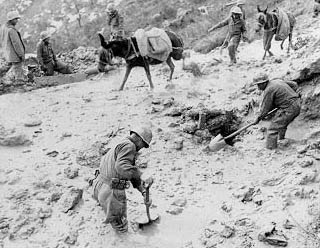
Soldiers work on a trail near Monte Grande, while an Indian pack mule
convoy returns from taking supplies to the front line.(DA
photograph)
As the Americans battled their way from mountain to mountain, Polish, Canadian, Indian, and British units of the Eighth Army attacked north of Rimini on 15 October in a continuation of the "battle of the rivers." Despite grueling combat which lasted until the end of the month, Eighth Army units failed to break through anywhere along their 30-mile front. They did manage, however, to create a new line from a point just south of Ravenna on the Adriatic coast through Forli and west to Faenza on the Fifth Army's right flank.
On 27 October, General Sir Henry Maitland Wilson, the Supreme Allied Commander in the Mediterranean, ordered a halt to these offensives. Many factors played a role in his decision, including increasingly stiff enemy resistance, Allied munitions and shipping shortages, troop exhaustion, the lack of replacements, and the even more rapidly deteriorating weather conditions. When combined with the continued Allied emphasis on combat operations in northwest Europe and southern France and the priority given those areas in terms of manpower, munitions, and supplies, Wilson had little choice.
23
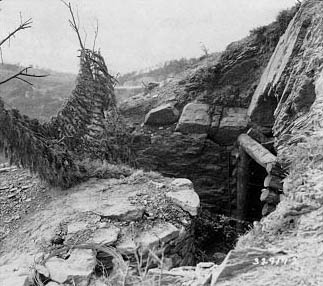
German defensive position: camouflaged log bunker.(DA photograph)
The intensity of the combat of September and October 1944 had a detrimental effect on the morale, readiness, and capability of the Allied forces in Italy. The already critical manpower shortages in Fifth and Eighth Armies were becoming so severe that their commanders predicted that if they continued to lose men at the same rate, both armies would have to cease operations for lack of replacements. Between 10 September and 26 October, II Corps' four divisions had suffered over 15,000 casualties, with the U.S. 88th Division alone losing over 5,000 men. During roughly the same period, Eighth Army casualties approached 14,000 men. Losses were so severe that on 10 October, Prime Minister Churchill asked the United States to send at least two additional divisions to the Italian front. His request was turned down by U.S. Army Chief of Staff General George C. Marshall, who preferred to send new U.S. units to France where significant progress was being made rather than to Italy for an increasingly bloody and
24
stalemated campaign in a secondary theater. Although the U.S. 10th Mountain Division was slated for Italian service and the black U.S. 92d Infantry Division as well as the Brazilian Expeditionary Force had arrived in the IV Corps' sector, all were undergoing training and were not yet ready for frontline deployment.
Field Marshal Alexander, still striving for an eleventh-hour breakthrough before winter, decided that another attempt on the German defenses should be made by both armies with whatever strength they could muster. Under his plan, the Fifth Army would rotate units from the front for rest and refitting and then return them to the line by 15 November in preparation for the new offensive. General Clark quickly fulfilled his part of this plan after receiving 3,000 replacements between 2-22 November. Even with these additional troops, Fifth Army units still were short some 7,000 men. Meanwhile, Eighth Army planners outlined another "one-two punch," ordering its units to attack to the northwest toward Imola and Budrio, and north toward Ravenna and beyond, at least drawing enemy units away from the Bologna area. After 7 December, or after the Eighth Army had taken Imola, whichever came first, Clark would launch the Fifth Army's assault with two divisions of the II Corps. Alexander ordered the offensive to begin on 2 December 1944, weather permitting.
Eighth Army forces attacked on schedule with heavy close-air support, but immediately ran into stiff enemy resistance from the 90th Panzer Grenadier and 98th Infantry Divisions. Although the Canadian 5th Armored Division entered Ravenna, a city liberated in large part by Italian partisans on 4 December, the Germans succeeded in stabilizing their front along the Senio River, ten miles farther north, and repulsed all subsequent attacks launched by Canadian, Polish, Indian, and New Zealand units. At the same time, Wilson withdrew several British and Greek units from the battlefront and sent them to Greece, diminishing the Eighth Army's offensive capabilities. When the British portion of the offensive failed to produce further gains, as the winter weather continued to deteriorate, and when it was reported that the Germans had not reduced their strength in the II Corps' area as anticipated' Alexander, on 7 December, announced the first of several postponements of further Allied offensive operations as the front temporarily quieted.
On 15 December 1944, a major reorganization of the Allied high command occurred due to the death of Field Marshal Sir John Dill, the chief of the British Military Mission in Washington. The Supreme Allied Commander in the Mediterranean, General Wilson, was selected to replace Dill, and Wilson's position was in turn assumed by Field Marshal Alexander. Subsequently, General Clark took command of the
25
15 Army Group in place of Alexander, while Maj. Gen. Lucian K. Truscott, Jr., returned from France to head the Fifth Army. General Sir Richard L. McCreery, who had replaced General Leese as Eighth Army commander on 1 October, remained in command of that force.
Major command changes also occurred within the opposing Axis forces during the same general time period. On 23 October 1944, Field Marshal Kesselring had been severely injured when his staff car collided with a towed artillery piece on a crowded mountain road; his subsequent recuperation virtually ended his effective command of Axis forces in Italy. Although he returned to duty in late January 1945, in early March Hitler gave him command of Army Group B in Western Europe, replacing Field Marshal Gerd von Rundstedt. General Vietinghoff commanded Army Group C until transferred to the Eastern Front in late January and then returned to permanently replace Kesselring in March 1945. General Lemelsen stood in for Vietinghoff in the Tenth Army until 17 February 1945, when he was replaced by Lt. Gen. Traugott Herr. At Fourteenth Army, Maj. Gen. Fridolin von Senger und Etterlin replaced Lemelsen before relinquishing command to Lt. Gen. Kurt von Tippelskirsch, who in turn gave Lemelsen his old command back in February. The rapid shifts among Axis commanders were obviously more disconcerting than those made in the Allied camp.
General Truscott arrived in Italy on 15 December 1944 and immediately received intelligence reports, based upon decrypted ULTRA intercepts of German radio traffic, of a suspected Axis buildup opposite the IV Corps. The buildup consisted of the German 148th Infantry and 157th Mountain Divisions and the Italian Fascist Monte Rosa and San Marco Marine Divisions. Transfer of the 16th SS Panzer Grenadier, 26th Panzer, and 5th Mountain Divisions to IV Corps' front was also thought imminent. As a precaution, Truscott attached the 339th and 337th regiments, 85th Division, and the 2d Brigade, 8th Indian Division, to IV Corps on 23 December, where they would be in a position to reinforce the relatively inexperienced U.S. 92d Division, then holding a six-mile sector between the Ligurian Sea and the Serchio River Valley.
Truscott completed these shifts just in time. On 26 December 1944, Axis forces launched Operation WINTERGEWITTER, a spoiling attack against the 92d Division twenty miles north of Lucca. Using eight infantry battalions supported by mortars and artillery, the enemy hoped to destroy completely the offensive capability of the 92d Division while simultaneously relieving the pressure that the Brazilian Expeditionary Force was exerting on the Italian Fascist Monte Rosa Division to the east in the upper Serchio Valley. General Crittenberger,
26
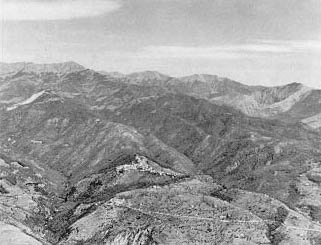
Mountains west of the Serchio River. (DA photograph)
the IV Corps commander, reacted quickly to the attack by rushing reinforcements from the U.S. 1st Armored, U.S. 34th, and 8th Indian Divisions to repel an Axis penetration of the 92d Division's front near Barga, a village just east of the valley, on the afternoon of the 26th. Axis forces, however, advanced only a few miles beyond Barga, before beginning a withdrawal on 27 December. Advancing soldiers of the 8th Indian Division, supported by aircraft of the XXII Tactical Air Command, then began four days of intense fighting in bitter weather and succeeded in pushing the now spent Axis forces back to their original positions.
In early January 1945 the Allies in Italy ceased large-scale military operations. In addition to the winter weather, five Eighth Army divisions and one corps headquarters had been moved to northwest Europe and Greece, further diminishing Allied capabilities in Italy. Alexander, Clark, Truscott, and McCreery, therefore, agreed to go on the defensive and use the winter months to prepare for new offensive operations scheduled for 1 April 1945. Despite two months of planning, limited offensives, and much maneuvering, Allied units came to rest on a winter line that had changed very little since late October 1944.
27
Axis forces, having successfully held the Gothic Line through the fall and early winter, also used the lull to rest and refit, sending two divisions, the 356th Infantry and 16th SS Panzergrenadier, to reinforce their Hungarian and Western fronts, respectively. Two other units, the 278th and 710th Infantry Divisions, replaced the departing units. While Kesselring expected limited Allied assaults during the winter months, he miscalculated both their timing and strength.
Early in the year Clark decided to launch three small attacks to obtain the best possible starting points for the planned spring offensive. The Eighth Army's Canadians began the first attack on 2 January 1945 along the Adriatic, quickly eliminating two enemy bridgeheads on the Senio River before consolidating their gains and digging in for the winter.
The second attack, a two-phased assault named Operation FOURTH TERM, lasted from 4-11 February 1945 and saw the U.S. 92d Division push back Italian Fascist forces in the Serchio River Valley area of IV Corps. The operation tested two inexperienced 92d Division regiments, the 365th and 366th. Although making progress
28
against the Italians, who melted away in face of the American advance, the offensive slowed as German forces were encountered. Mine fields, stiff resistance, and strong counterattacks, which overran several units, finally caused the American assault to break down. Further offensive action by the 92d Division was impossible, and the unit pulled back to its original position, having suffered over 700 casualties in four days.
The third limited attack, Operation ENCORE, was the result of a change in Allied operational strategy that eliminated the heavily fortified city of Bologna as a spring objective and, instead, focused on securing exits from the northern Apennines directly into the Po Valley itself. The U.S. 10th Mountain Division began arriving in Italy on 27 December 1944. Its mission was to capture the high ground on the right wing of the IV Corps and eliminate enemy positions overlooking Allied forces so that the spring offensive could be shifted westward to bypass Bologna. Although only a small Axis force held the area, the 10th Mountain Division was provided with reinforcements of artillery, armor, and antitank weapons, as well as infantry support from the Brazilian Expeditionary Force.
The first phase of the assault began on 19 February 1945 with a battalion of the 10th Mountain Division successfully climbing the cliff face of Riva Ridge, surprising enemy forces there and forcing them to retreat. Continuing their attacks to the northeast, the Americans captured Monte Belvedere and Monte delta Torraccia by 23 February. A second 10th Mountain Division attack against recently reinforced German positions on ridges farther to the northeast began amid worsening weather conditions on 3 March, but also succeeded. By 5 March, the 10th Mountain Division had occupied a solid line of ridges and mountain crests that placed Allied forces in excellent positions for further offensive operations in the spring.
Except for these limited attacks, the Allies contented themselves with resting, receiving reinforcements, and stockpiling munitions, especially artillery shells and other supplies. During the month of January 1945, a round robin replacement of units at Fifth Army gave everyone a brief rest from frontline duty. By late March, the Japanese-American 442d Regimental Combat Team returned from France and the Italian Legnano Combat Group moved from Eighth to Fifth Army control. An additional number of Allied artillery and antitank units also arrived. As spring approached, the fully rested and resupplied 15 Army Group prepared to renew the offensive in a campaign that most anticipated would take it into the Po Valley and mark the final Allied push of the war in Italy.
29

Northern Apennines, IV Corps' sector. (DA photograph)
Analysis
The northern Apennines fighting was the penultimate campaign in the Italian theater. Although the Allies steadily lost divisions, materiel, and shipping to operations elsewhere, which diminished their capabilities, their offensives prevented the Axis from substantially reinforcing other fronts with troops from Italy. Yet the transfer of units from Fifth and Eighth Armies for use in northwest Europe, southern France, and Greece, both after the capture of Rome and during the North Apennines Campaign itself, left Allied commanders with just enough troops to hold Axis forces in Italy but without sufficient forces to destroy the enemy or to end the campaign.
The Allies attacked the Gothic Line in the fall of 1944 with hopes of a quick breakthrough and the rapid destruction of Axis armies on the plains of the Po Valley. Given the depth of the German defenses and the highly compartmentalized terrain, however, the Allies' progress had been disappointingly slow. Weather delayed the advance north, especially with the onset of winter, but more important was the lack of powerful and mobile reserves able to rapidly exploit local suc-
30
cesses. Although Allied armies in Italy successfully tied up Axis forces desperately needed elsewhere, they could not break Axis positions or morale until the final offensive in April 1945.
As they had in 1943-44, the Germans took great advantage of the rugged Italian terrain and mounted an effective defense that largely negated Allied manpower, air, armor, and artillery superiority. With the excellent lateral road network in the Po Valley, the defenders easily transferred troops from different parts of their front to reinforce threatened sectors. The Allies, on the other hand, had to move supplies and troops over circuitous mountain routes. Although they had captured Leghorn and had begun restoring its harbor before the beginning of the North Apennines Campaign, the supplies off-loaded there moved slowly and tortuously through the mountains to reach the men on the front line.
The combat in the northern Apennines demonstrated the valor, courage, resilience, and determination of the average Allied soldier. The compartmentalized terrain put a premium on small unit leadership and the fighting spirit of the individual soldier. Battling over treacherous ground, often in rainy weather with mist or fog, against an often unseen, highly motivated, and determined enemy, the Allied troops persevered. Their effort and their survival as an effective fighting force during the winter of 1944-45 set the scene for the breakthrough and rapid advances which were to take place in the Po Valley in the spring of 1945.
31
Further Readings
For campaign overviews, see Carlo D'Este, World War II in the Mediterranean, 1942-1945 (1990); G. A. Sheppard, The Italian Campaign (1968); Douglas Orgill, The Gothic Line, Autumn 1944 (1967); Higgins Trumbull, Soft Underbelly, the Anglo-American Controversy over the Italian Campaign (1958); and Michael Howard' The Mediterranean Strategy in the Second Word War (1968). The official histories are MAAF, Air Power in the Mediterranean, November 1942-February 1945 (1945); and the nine-volume Fifth Army history condensed in From Salerno to the Alps (1948), Lt. Col. Chester G. Starr, ed. The most comprehensive work on the Italian campaign remains Ernest F. Fisher, Jr., Cassino to the Alps (1977), which also lists in its bibliography the official campaign histories of British, Canadian, Indian, New Zealander, French, Brazilian, and South African forces in Italy. An excellent description of combat conditions is provided in Klaus H. Huebner, A Long Walk Through War: A Combat Doctors Diary (1987). For the role of code-breaking, see Ralph Bennett, Ultra and Mediterranean Strategy (1989); and F. W. Winterbotham, The Ultra Secret (1974).
Postwar memoirs give the commanders' perspectives and include Mark Clark, Calculated Risk (1950); Lucian K. Truscott, Jr., Command Missions (1954); Albert Kesselring, A Soldier's Record (1954); Winston Churchill, Closing the Ring (1951); and Nigel Nicholson, Alex, the Life of Field Marshal, Earl Alexander of Tunis (1973), with Gen. Fridolin von Senger und Etterlin, Neither Fear nor Hope (1954), being one of the best.
CMH Pub 72-34
Cover: Infantrymen advance over the hills of Il Giogo Pass.(DA photograph)

